Nonprofits are all about facilitating change and spreading awareness of their causes. But supporters won’t come to you until you offer a compelling reason to get involved.
Your nonprofit’s outreach campaigns are essential marketing tactics for your cause. Behind every successful marketing campaign is a detailed plan that makes it all come together.
Just as there are nuanced differences between nonprofit and for-profit marketing, there are important distinctions between nonprofit and for-profit marketing plans.
Let’s explore the intricacies of nonprofit marketing plans in this ultimate guide for beginners!
Nonprofit Marketing Plan FAQs
What is a nonprofit marketing plan?
The way the Fifty & Fifty team sees it, a nonprofit marketing plan is a document dedicated to laying out your marketing campaigns through every phase of the process.
A nonprofit marketing plan allows your team to take a unified and data-driven approach to your outreach efforts. Much like your campaigns, your marketing efforts should be completely unique to your nonprofit’s goals, audience, and mission. A nonprofit marketing plan can also take on different sizes and structures depending on the scope of your campaign. We’ll cover numerous use cases for a nonprofit marketing plan in this guide.
What is the value of a structured nonprofit marketing plan?
With an effective nonprofit marketing plan, your nonprofit can:
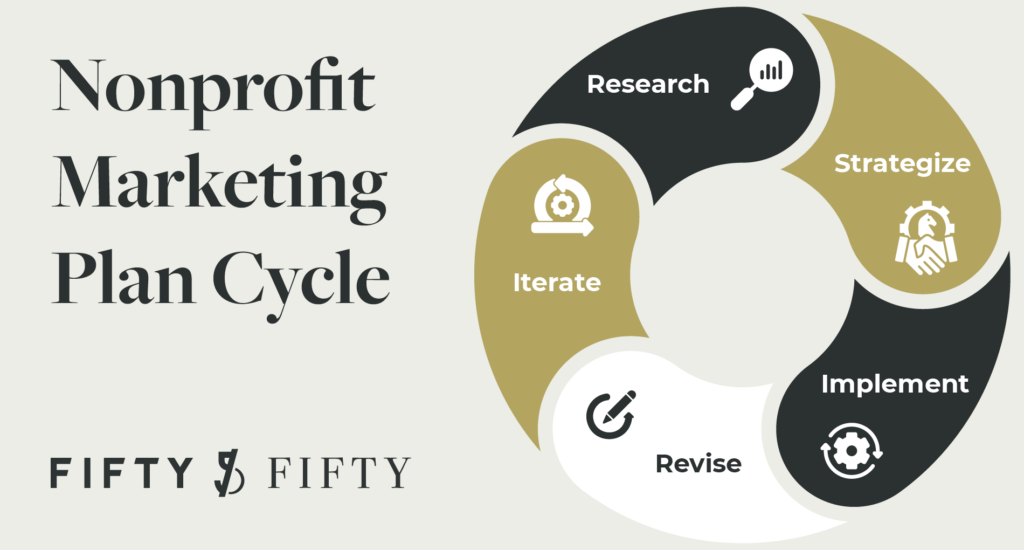
- Enhance efficiency. For some campaigns, it can take days or even weeks to decide on the best course of action, meaning you don’t want to waste any time rethinking strategy down the road. Laying out your timelines from the get-go eliminates the guesswork you might experience later, saving precious time in the process.
- Mitigate risk. With important funds and time on the line, planning your approach ahead of time helps you foresee and address any risks to your strategy.
- Uniting your teams’ brand presentation. Keeping your team on the same page is crucial for preventing mission drift and presenting a unified approach to your marketing efforts.
- Measure success and iterate on strategies. By outlining your key performance indicators (KPIs) during the planning process, you can start tracking them earlier and get a more complete dataset.
Plus, you can boost your marketing plan’s ROI even further by collaborating with a nonprofit marketing agency—more on that later. Now that you understand the benefits of planning nonprofit marketing campaigns, let’s review the pitfalls so you know how to avoid them.
What are the common pitfalls in nonprofit marketing planning?
While developing a nonprofit marketing plan is crucial for success, there are still difficulties you might encounter when first starting the planning process. Consider these common pitfalls you might experience and these key solutions:
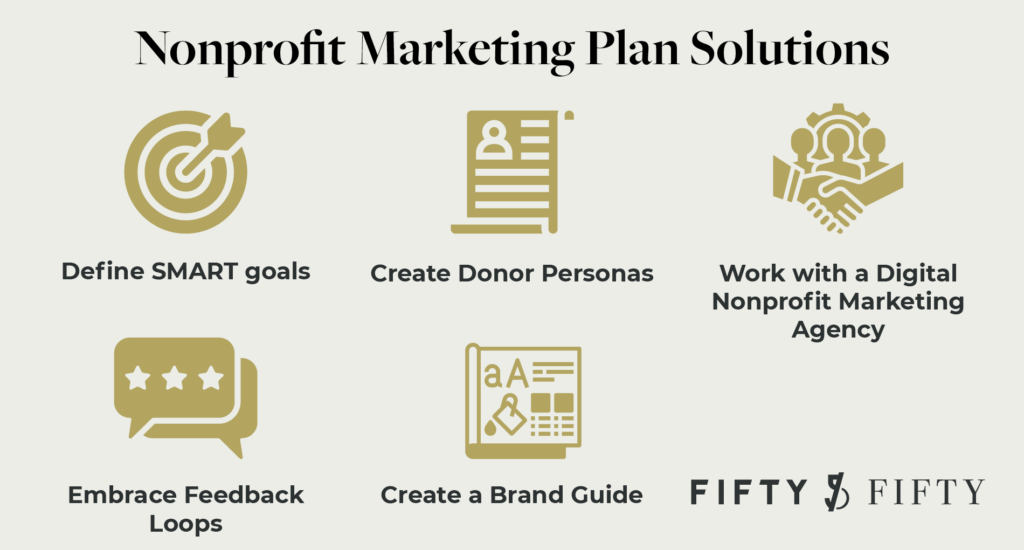
- Lack of clear objectives. The main purpose of developing a marketing plan is to clarify your goals so that they have the level of precision required to really make an impact. Ensure your marketing goals follow the SMART framework by making them specific, measurable, attainable, relevant, and time-bound.
- Not understanding your target audience. A key aspect of a strong nonprofit marketing plan is having an in-depth comprehension of your target audience. To truly understand your target audience’s mindset, create marketing personas. These fictional profiles help you step into a hypothetical audience member’s shoes, providing you with a more nuanced understanding of their motivations and struggles.
- Lack of digital reach. The massive audience on digital channels can be a blessing and a curse for marketers. They provide unprecedented visibility, but also unprecedented competition for views. Consider working with a nonprofit marketing agency that specializes in digital channels. They can help you identify the best channels for your nonprofit and create content that resonates with your target audience.
- Lack of input from supporters. It can be easy to plan your nonprofit marketing campaign in a vacuum. However, to achieve the best results, you need input from outside your organization, and your supporters are the best place to start. Consider gauging different messaging techniques’ effectiveness by conducting A/B testing. Or, you could ask your supporters for their feedback with a quick survey. Either way, you’ll get actionable feedback that’s valuable for adjusting your strategy as needed.
- Inconsistent brand messaging. As previously mentioned, your nonprofit can foster brand awareness and engagement by presenting a consistent message. If you have multiple people working on a marketing plan, you want to avoid presenting conflicting messages through your campaigns. Steer clear of this outcome by creating a detailed brand guide that outlines everything from your mission statement to your color scheme. For example, take this fictional example from our guide to nonprofit branding:
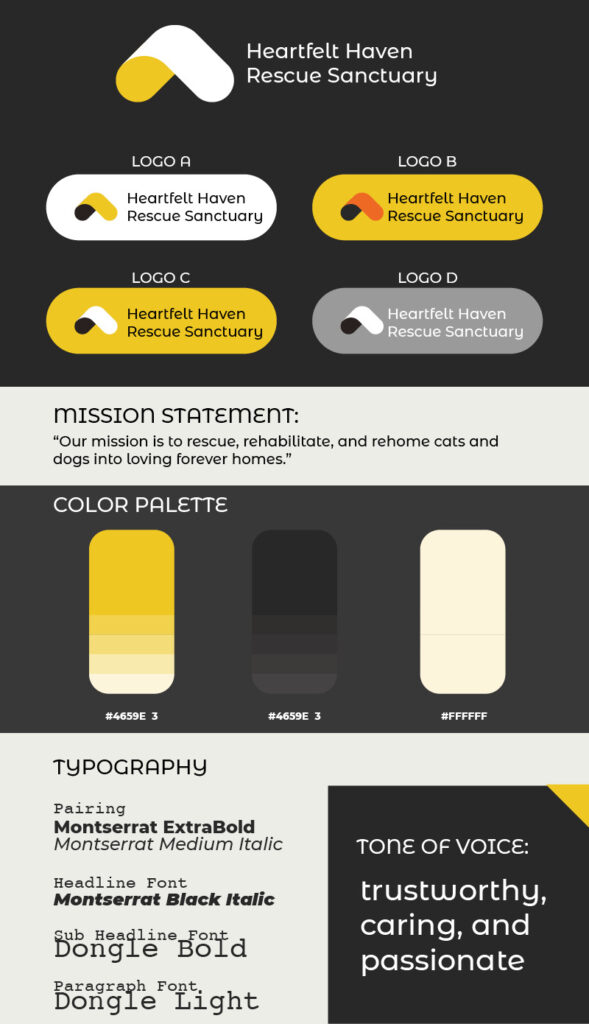
No matter what ideas you have for your nonprofit marketing campaign, you can surmount hurdles by proactively expecting and correcting them. This list can provide a good jumping-off point, but you should consider your nonprofit’s own strengths and weaknesses when creating your list of challenges.
What differentiates a nonprofit marketing plan from a for-profit one?
There are multiple similarities and distinctions between your plan and a for-profit company’s. For the purpose of this content, we’ll focus on the main one: campaign purpose.
While businesses usually focus marketing efforts on converting the audience into customers and making a profit, your nonprofit might have multiple mission-driven objectives in mind for your campaigns. For instance, you might be running a campaign that simply aims to spread awareness of your mission, whereas others might intend to recruit volunteers or raise funds.
That said, it helps to think like a business when planning your nonprofit marketing campaign in certain ways. You should always be cognizant of how much time and money you’re spending on creating marketing campaigns so you can boost your return on investment (ROI). However, always keep your mission and beneficiaries as your top priority so your marketing messages feel genuine.
How often should a nonprofit marketing plan be reviewed and updated?
Remember that your nonprofit marketing plan should be a living document. Changes to your plan will depend on many factors, such as current events and your nonprofit’s evolution. You might reevaluate your marketing plan after:
- Major external events. Sometimes, events outside of your control can significantly impact your campaigns. For example, many nonprofits experienced major upheaval recently due to inflation and needed to reallocate their marketing budget.
- Organizational changes. Internal shifts such as staff and board turnover can influence your marketing campaigns’ directions, as different staff members have different marketing opinions and leadership styles.
- Technological advancements. Digital marketing channels are becoming increasingly widespread and accessible. For instance, if your nonprofit gets approved for the Google Ad Grant program in the middle of a campaign, you’ll likely need to revisit your multi-channel strategies.
- A major campaign wraps. Your nonprofit could be in a completely different financial situation after a fundraising campaign. Whether you raised more or less than you projected, you might need to adjust your marketing budget.
- You start working with a nonprofit marketing agency. No matter what type of consultant you work with, they’ll have suggestions for improving your current strategies. Nonprofit marketing professionals will likely lay out an entirely new or adjusted plan for you that’s optimized for success.
That said, you don’t need to experience a significant event to make you evaluate your nonprofit marketing plan. Periodic check-ins based on your KPIs are very useful in preventing or solving any issues. Just ensure that you don’t overwrite the original marketing plan; instead, keep the old versions in an archived folder so you can refer back to them if needed.
Can a small nonprofit still benefit from using a detailed marketing plan?
The short answer is yes! Any and all nonprofits investing time and money into marketing should plan their efforts in advance. In fact, using a detailed marketing plan can be even more useful for small nonprofits because it allows:
- Resource optimization. For professionals just starting out with nonprofit marketing, determining where to place resources for the best return can be challenging. A marketing plan provides a clear picture of where funds are going and why.
- Consistency. Furthermore, following a consistent schedule for writing and publishing marketing materials is crucial to getting the most out of your campaign. Use a nonprofit marketing plan to lay everything out and make your goals more achievable.
- Accountability. By assigning team members action items based on your marketing plan, you promote accountability and a hardworking attitude on your team.
The main distinction between nonprofit marketing plans for large and small organizations is the comprehensiveness of the plan. Ensure your plan is the right complexity for your nonprofit so you don’t bite off more than you can chew.
Essential Components for Creating a Nonprofit Marketing Plan
Now that your initial questions have been answered, you might want to jump right into creating your own nonprofit marketing plan. Let’s go over the most important elements you should keep in mind.
1. SWOT Analysis
We’ve gone over the importance of setting SMART goals, but there’s another important aspect of goal-setting that contextualizes your objectives: a Strengths, Weaknesses, Opportunities, and Threats analysis. This framework helps you synthesize internal and external factors and how they impact your nonprofit’s marketing campaigns. Let’s conduct a SWOT analysis for the fictitious nonprofit Heartfelt Haven Rescue Sanctuary (HHRS):
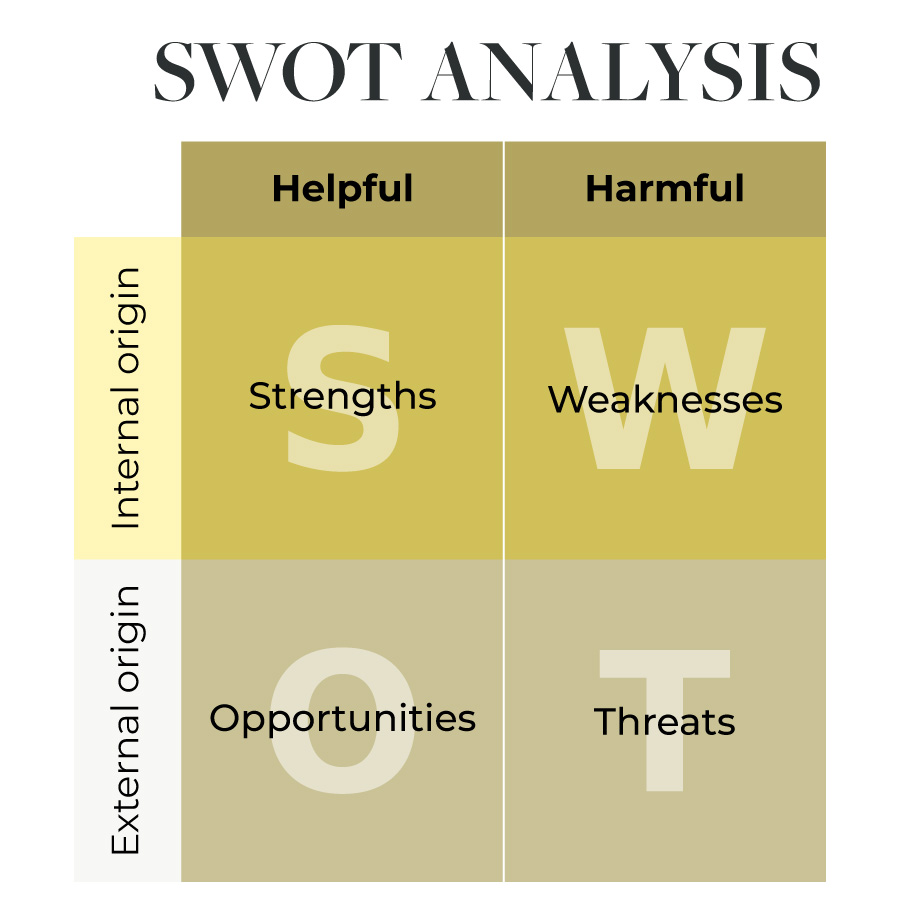
- Strengths (internal): HHRS has an extensive library of images and videos of real pets in their care that’s useful for marketing. Also, HHRS has a loyal and seasoned team that can speak to the organization’s impact extremely well.
- Weaknesses (internal): Like many other nonprofits, HHRS is focused on the welfare of their animals above everything else and has a limited marketing budget. They also have a limited digital presence compared to other shelters in the area.
- Opportunities (external): Expanding into digital marketing channels is key for HHRS. Also, if they’re financially able to, hiring a team member dedicated to marketing or working with a nonprofit marketing agency can greatly boost their capacity.
- Threats (external): HHRS has experienced decreased donations in the wake of economic challenges in their local community, limiting their budget. Also, the prevalence of other shelters in the area dilutes their marketing visibility.
Conducting a SWOT analysis shouldn’t be a static process. Review your own nonprofit’s relevant strengths, weaknesses, threats, and opportunities to determine how each of these elements will affect your unique marketing situation. Much like you update your marketing plan, ensure you adjust your SWOT analysis when you pivot your strategies.
2. Target Audience Personas
In this section of your marketing plan, define the different segments of your target audience and create personas for them. Here are two examples for HHRS:
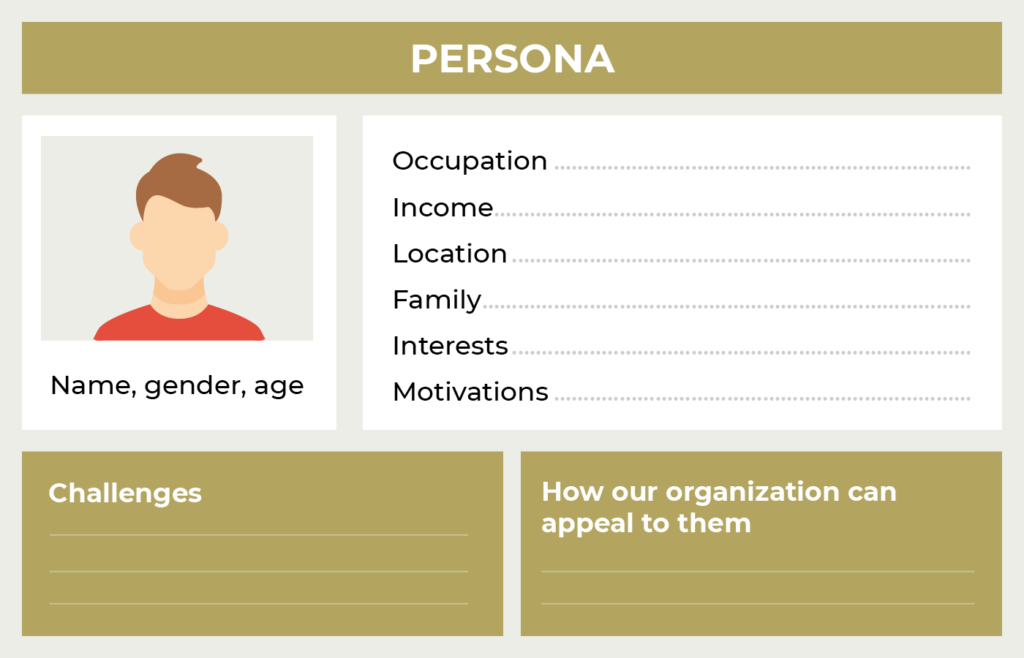
Potential Donor/Volunteer
- Name: David Kim
- Gender: Male
- Age: 40
- Occupation: Veterinarian
- Income: $100,000 per year
- Location: Works in the big city, but lives in a quiet nearby suburb
- Family: Between two and four young children and a husband or wife
- Interests: Animal welfare, spending time with family
- Motivations: Promoting animal welfare, family values, and community upkeep. Contributing part of his income and his free time to causes bigger than himself. Wants to instill charitable values in his children.
- Challenge: Hectic work schedule.
- How HHRS can appeal to him: Offer family volunteering opportunities, recurring donation programs that don’t require manual upkeep, and provide regular updates of the animals that his donations are supporting.
Potential Adopter
- Name: Alexandra Gomez
- Gender: Female
- Age: 25
- Income: $70,000 per year
- Location: Lives alone in an apartment in the big city
- Family: Single without children
- Interests: Making connections despite working remotely, social justice, and plant care
- Motivations: Desires companionship and something to take care of beyond plants
- Challenges: Not ready for kids yet and experiences loneliness due to remote work. Her apartment isn’t big enough for a large pet and she doesn’t have time to go for long walks. Money is tight living in the big city.
- How HHRS can appeal to her: Offer free vaccines, follow-up care, a reduced adoption fee, and food for the first few months of owning the pet. Suggest adopting indoor pets, such as cats, who are well-suited to apartment life and remote work.
By creating donor personas like these that are specific to your nonprofit’s goals, you can easily create marketing materials that resonate with your target market.
3. Channel Selection Rationale
Remember that it’s better to focus on quality rather than quantity when choosing your marketing channels. In this section, lay out not only which channels you want to use but why you want to use them. For instance, you can use the following criteria to justify your choice:
- Audience Presence/Visibility
- Content Suitability
- Engagement Rates
- Cost-Effectiveness
- Integration with Current Tools
- Feedback and Data Collection Opportunities
If there’s a reason you want to use a certain marketing tool that isn’t present on this list, ensure you mention and explain it to round out your rationale section.
4. Content Strategy Rundown
Selecting your channels and developing marketing personas are only the first steps in developing your content strategy. Contextualize all of your data and use it to inform the story you want to tell through your marketing materials. Based on the personas outlined above, let’s go over two example content strategies:
For David
David is in his early forties and is active on Facebook. He also checks his email regularly since he occasionally handles urgent patient matters. HHRS should plan on sending him through the donation funnel via email and social media, advertising the benefits of donating and volunteering. Ensure that animal welfare, family volunteering opportunities, and convenient donation methods are the main focus.
For Alexandra
Alexandra is in her mid-twenties and spends more time on social media platforms like Instagram and TikTok. Start at the top of the funnel by creating short-form videos describing the benefits of raising a pet, such as reduced loneliness and heightened emotional support. Feature HHRS’ adorable animals heavily. Then, pull her to the bottom of the conversion funnel by advertising why HHRS is the best shelter for new pet adopters due to its reduced adoption costs and apartment-friendly animals.
These two distinct, yet complementary techniques demonstrate how nonprofits can present a unified message while resonating with different audiences.
5. Budget Allocation
In this section, you’ll lay out your projected marketing budget. Remember to include these categories:
- Fixed costs, such as the retainers for a nonprofit marketing agency, marketing software, and staff
- Campaign-specific costs, such as the cost of content creation
- Contingency funds in case of an emergency
- Estimated revenue streams
All of these budgeting considerations help you assess your campaign’s ROI once it’s time to check in again.
6. KPIs and Metrics
Whether you’re aiming to boost donations or simply spread awareness of your mission, establishing relevant metrics ahead of time is crucial. Consider the following metrics that you could use for your campaign:
- Social media engagement, such as followers, comments, shares, and likes
- Email engagement, such as click-through rate and open rate
- Awareness metrics, such as website traffic, brand mentions online, and impressions online
- Financial metrics, such as ROI and cost per acquisition (CPA)
Ensure that whichever metrics you decide to leverage are easily measurable. For example, if you’re running a social media campaign, you should understand how different platforms collect analytics and what they mean.
7. Feedback Mechanisms
To round out your nonprofit marketing plan, highlight how you’ll collect and incorporate feedback from external parties throughout your campaign. Some effective ways to measure external feedback include:
- Adding “how did you find us” surveys on your donation and volunteer pages
- Sending marketing surveys to existing supporters who understand your nonprofit
- Monitoring KPIs when new strategies are implemented
- Reading comments on digital marketing materials
- Leveraging focus groups
No matter which strategy you use, make sure that you have a reliable way to collect and store data. NPOInfo recommends using marketing software that integrates with your CRM so you always understand how donors are responding to your marketing efforts.
How to Level Up Your Nonprofit Marketing Plan
So, once you make a winning nonprofit marketing plan, what’s next? It’s time to analyze and iterate on your plan to improve your approach. Here are some ways for you to level up your techniques:

- Set more defined KPIs. As your nonprofit grows and changes, your KPIs should too. Fine-tune your KPIs over time so they’re aligned with your nonprofit’s current priorities and resources.
- Plan for multi-channel integration. There are always new marketing opportunities on the horizon. After aligning your strategies across your existing channels, research new channels that could be a good fit and work them into future marketing plans.
- Invest in training and development. When you’re just starting off your marketing efforts, chances are your team members aren’t pros in outreach and strategic communicating yet. Invest in educational materials, such as online classes and marketing books, that can help your team get up to speed.
- Use a nonprofit marketing agency. As previously mentioned, enlisting the help of a professional marketing agency that specializes in nonprofits can supercharge your campaigns and transform your brand image. Fifty & Fifty, the top marketing agency for nonprofits, offers custom-made solutions for large-scale nonprofit marketing operations. If you have room in your budget, working with the team is a surefire way to smash your marketing goals and make a real impact.
Remember, there’s always room for improvement! For example, if you started off without the help of a nonprofit marketing agency, consider adding it to your plan as you scale up your operations.
Wrapping Up
It’s time for you to create a nonprofit marketing plan custom-built for your organization. No matter what your campaign focus is, as long as you keep your team in the loop and contextualize goals in the short- and long-term, you can cultivate an airtight strategy for years to come!
Additional Resources
- The Art of Nonprofit Branding: 3 Examples and Best Practices. Learn the ins and outs of nonprofit branding so you can take a unified approach to your marketing campaigns.
- Nonprofit Digital Marketing – Making Your Mark Online. The digital world is full of possibility for your nonprofit. It just takes a trained eye to spot the best opportunities. Learn how to here!
- Nonprofit Marketing Agency: Share Your “Why”. If you’re sold on working with a nonprofit marketing agency, check out our list of the top providers on the market.







